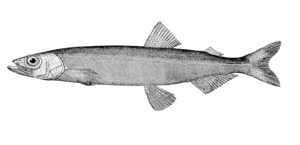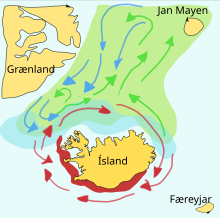Capelin
| Capelin | ||||||||||||
|---|---|---|---|---|---|---|---|---|---|---|---|---|

Capelin ( Mallotus villosus ) |
||||||||||||
| Systematics | ||||||||||||
|
||||||||||||
| Scientific name of the genus | ||||||||||||
| Mallotus | ||||||||||||
| Cuvier , 1829 | ||||||||||||
| Scientific name of the species | ||||||||||||
| Mallotus villosus | ||||||||||||
| ( Müller , 1776) | ||||||||||||
| Subspecies | ||||||||||||
|
The capelin or capelan ( Mallotus villosus ) is a small fish from the smelt family that lives in large schools in the Arctic Ocean . It can also be found in stores under its English name Capelin .
Occurrence
The capelin is a schooling fish . The biomass of the giant swarms can amount to millions of tons in some areas. They live at a depth of up to 300 meters.
The common capelin ( Mallotus villosus villosus ) lives, depending on the season, in the Arctic Ocean from the White Sea via the Barents Sea and in the North Atlantic up to the level of Newfoundland . The subspecies Mallotus villosus socialis (also called Pacific Capelin ) lives in the North Pacific from the Bering Strait to the heights of Japan and Korea .
Appearance and name
The males are around 20 cm long, the females up to 25 cm. The back is olive colored with a flowing transition to the silver flank and belly scales. The very small scales are surrounded by dark dots. The body shape is slim and only slightly arched. The teeth are tiny and barely visible.
During the spawning season, the males have rows of hair-like scales on their sides, probably for the purpose of better contact with females during spawning. They remind allegedly on the clothes of a priest or possibly a monk's tonsure , so the fish in France the name capelan carries ( Old French for Kaplan , from the medieval Latin cappelanus ), of which the English name capelin and the German capelin is derived. The name Capelin (n) , old Norse loðinn 'shaggy', and the Latin epithet villosus 'shaggy', ancient Greek μαλλωτός 'hairy', comes from this villi .
Life cycle

Green area: feeding areas for the adult animals.
Blue area: habitat for young animals.
Green and blue arrows: migration in search of food.
Red area: spawning areas.
Red arrows: migration during spawning season
Capelin is two to five years old. The swarms spend most of their lives on the high seas, until parts of them go to spawn in the shallow and warmer waters near the coasts once a year. Preferred spawning sites are the coasts of Newfoundland , Greenland and Russia , the south coast of Iceland and the fjords of Finnmark , where they often penetrate into brackish and fresh water . The Pacific subspecies spawns on the coasts of Alaska and British Columbia . The spawning times are between March and October, depending on the location.
In order to lay the spawn in the shallow surf water and to fertilize it, the males hold the females with their pectoral and pelvic fins and the hair-like villi. A single female lays between 6,000 and 12,000 eggs, which stick together in clusters. The surf washes the eggs up to 10 centimeters deep into the seabed, where the young hatch after 15 to 20 days. Many of the fish spawn only once in a lifetime, as most, almost all of the males, die immediately after spawning. Large numbers die from exhaustion, injuries or are washed up on the beach before they fall prey to seabirds and seals in the shallow coastal waters . Due to the increase in the water temperature in the period from 1995 to 2019, the capelin populations have migrated significantly to the north.
Food chain
Capelin is an important part of the food chain in spawning areas . Spawning and fry are an important source of food for the cod . Large heats of cod follow the capelin into their spawning areas. Numerous seabird species also depend on their regular spawning.
The capelin itself mainly feeds on animal plankton on the edge of the ice shelf . Adult capelin also eat krill , small shellfish and fish. Their food competitors include the polar cod and herring .
fishing
The regional fishery has been catching the capelin in its spawning areas since time immemorial , in Greenland the fish is called amasette . However, since the 1950s it has been caught on an industrial scale with pelagic trawls on the high seas. Since then, the catch has risen sharply. The commercial exploitation of capelin increased in the 1970s until the whole population was at risk. Catches containing too many males have often been dumped directly into the sea in commercial fisheries because they are less profitable.
The overfishing of capelin decimated the stocks of cod and competing species such as the Arctic cod. It is estimated that around 100 tons (1:15 ratio) of capelin are required to produce seven tons of cod fillet.
State-regulated fishing quotas have existed since the 1980s. The main catching countries are Norway , Russia , Iceland and Canada , where there are national maximum catches. The stock of capelin is monitored by the national environmental protection authorities. By the early 1980s, capelin stocks were at a critical low; they have only partially recovered since then, despite the catch restrictions.
The females are caught mainly for their roe , which is commercially available as "capelin roe" or " Icelandic caviar ". Capelin is also a popular food fish, especially in Japan ("Shishamo", the fish is dried for a day and then grilled). Capelin is consumed as dried fish in its spawning areas. The males are processed as so-called "industrial fish " into fish meal and fish oil .
swell
- H. Vilhjálmsson: On the biology and changes in exploitation and abundance of the Icelandic Capelin (English)
- Catch regulation and statistics ( PDF , English; 986 kB)
Individual evidence
- ↑ Anja Jardine in NZZ from October 25, 2019: All over the world the ice is melting inexorably. What happens if the climate changes?
Web links
- Capelin on Fishbase.org (English)
